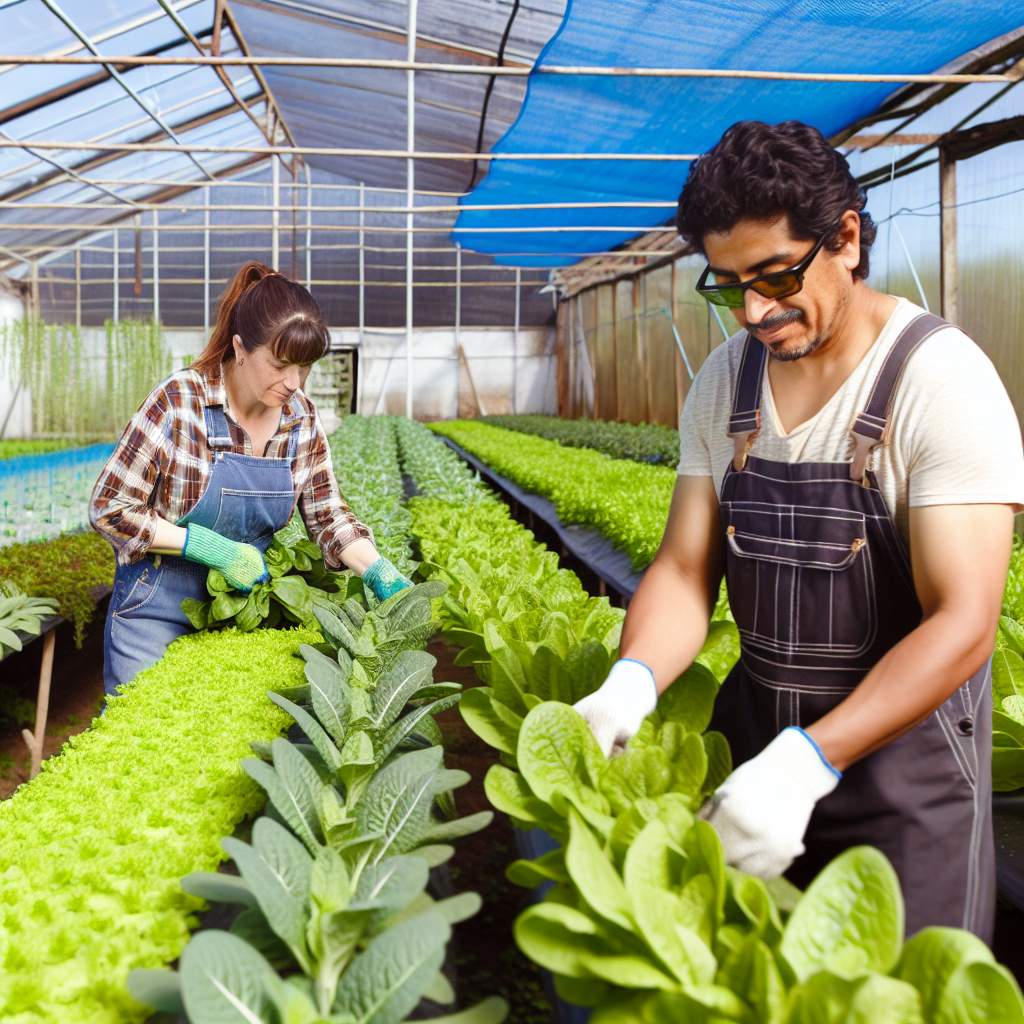Introduction to Greenhouse Cultivation and Its Importance
Greenhouse cultivation has revolutionized the agricultural landscape in the USA.
This method offers a controlled environment for growing specialty crops.
Consequently, it allows farmers to extend their growing seasons.
Moreover, greenhouse cultivation enhances crop yield and quality.
It minimizes exposure to pests and diseases, reducing the need for harmful pesticides.
This approach is vital in meeting the increasing food demand.
The Role of Controlled Environments
Controlled environments optimize conditions for plant growth.
They regulate temperature, humidity, and light levels efficiently.
As a result, crops can thrive even in adverse weather conditions.
Benefits of Greenhouse Cultivation
- Increased crop yield due to controlled conditions.
- Protection against extreme weather and pests.
- Ability to cultivate a diverse range of specialty crops.
- Reduced labor costs through automated systems.
Commercial Viability of Specialty Crops
Specialty crops often yield higher market prices compared to traditional crops.
Greenhouse facilities can produce crops year-round, enhancing profitability.
Additionally, they cater to niche markets, creating opportunities for small-scale farmers.
Impact on Sustainability
Greenhouse cultivation promotes sustainable farming practices.
This method uses resources more efficiently, reducing waste.
Furthermore, it can incorporate organic and eco-friendly practices.
Transform Your Agribusiness
Unlock your farm's potential with expert advice tailored to your needs. Get actionable steps that drive real results.
Get StartedConsequently, it contributes to long-term environmental health.
Benefits of Growing Specialty Crops in Greenhouses
Enhanced Control Over Growing Conditions
Greenhouses provide a controlled environment for crops.
Growers can manage temperature, humidity, and light levels effectively.
This control leads to improved plant health and productivity.
Moreover, it allows for year-round cultivation regardless of external conditions.
Higher Yields and Quality
Specialty crops grown in greenhouses often yield more produce.
The enclosed environment protects plants from pests and diseases.
Consequently, this protection reduces crop losses.
Moreover, greenhouse crops can often be of higher quality.
This can result in premium pricing in the market.
Extended Growing Seasons
Greenhouses allow for earlier planting and later harvesting.
This extended season increases overall production capacity.
Farmers benefit from selling crops when market prices are higher.
Additionally, this flexibility diversifies income opportunities.
Water Efficiency
Greenhouses enable more efficient water usage compared to traditional farming.
Drip irrigation systems can minimize waste and runoff.
This conservation of resources benefits both the environment and growers.
Moreover, it helps maintain consistent moisture levels for plants.
Access to Niche Markets
Growing specialty crops can open doors to niche markets.
Consumers increasingly seek organic and locally sourced options.
Specialty crops often command higher prices in these markets.
This can create lucrative business opportunities for growers.
Reduced Labor Requirements
Automation in greenhouses can reduce labor costs significantly.
Advanced technology can assist with watering, fertilization, and monitoring.
Showcase Your Farming Business
Publish your professional farming services profile on our blog for a one-time fee of $200 and reach a dedicated audience of farmers and agribusiness owners.
Publish Your ProfileThese efficiencies lead to an overall reduction in operational costs.
Furthermore, less manual labor helps to alleviate workforce challenges.
Sustainability and Environmental Impact
Greenhouse cultivation can promote sustainable farming practices.
It reduces the carbon footprint associated with food transportation.
Additionally, it often involves renewable energy practices.
These methods contribute to environmental conservation efforts.
Moreover, local production reduces dependence on large-scale agriculture.
Selecting the Right Greenhouse Structure for Different Climates
Understanding Climatic Needs
Different climates require specific greenhouse structures for optimal plant growth.
Understanding local weather patterns can greatly influence your greenhouse choice.
Climate including temperature and humidity directly affects plant health and yield.
For warmer regions ventilated greenhouses allow for airflow and reduce heat build-up.
In contrast colder areas benefit from structures designed for heat retention.
Types of Greenhouse Structures
Several greenhouse types cater to varying climatic conditions.
Popular options include Gothic A-frame and Quonset structures.
Gothic greenhouses have peaked roofs for snow runoff in colder areas.
A-frame greenhouses are versatile and can perform well in diverse weather conditions.
Quonset greenhouses provide ample space and are cost-effective for larger operations.
Material Selection
The materials used for greenhouses also play a crucial role in climate adaptation.
Glass greenhouses offer excellent light transmission but may increase heat loss.
Polycarbonate panels provide insulation while maintaining light for plant growth.
Plastic films are lightweight and affordable but may require frequent replacement.
Ventilation and Heating Systems
Efficient ventilation systems ensure air circulation within the greenhouse.
In warm climates automated vents or exhaust fans help control temperatures.
Cold climates can benefit from supplemental heating systems to maintain optimal conditions.
Consider heating options such as electric heaters natural gas or even geothermal systems.
Interior Layout Considerations
The layout inside the greenhouse impacts plant growth and accessibility.
Rows of plants should allow enough space for maintenance and harvesting.
Utilizing vertical space can enhance productivity in smaller greenhouses.
Consider incorporating movable benches for flexible growing spaces.
Monitoring and Control Systems
Implementing monitoring systems can optimize plant health in varying climates.
Temperature and humidity sensors help maintain ideal growing conditions.
Automated systems can adjust ventilation or shading based on real-time data.
Smart technology ensures efficient energy use and minimizes operational costs.
You Might Also Like: Crop Disease Management for Reducing Costs in Farm Operations
Key Specialty Crops Suitable for Greenhouse Production in the USA
Introduction to Specialty Crops
Specialty crops refer to a diverse range of plants cultivated for various purposes.
They provide significant economic value and cater to niche markets.
Greenhouses offer optimal conditions for growing specialty crops year-round.
Herbs and Aromatics
Herbs are increasingly popular due to their culinary and medicinal uses.
Basil grows well in greenhouse settings.
Cilantro thrives in greenhouses.
Showcase Your Farming Business
Publish your professional farming services profile on our blog for a one-time fee of $200 and reach a dedicated audience of farmers and agribusiness owners.
Publish Your ProfileMint also performs well inside greenhouses.
Aromatic herbs can command high prices in local markets.
These crops require relatively little space for production.
This characteristic makes them ideal for small-scale growers.
Exotic Fruits
Exotic fruits bring unique flavors and appeal to consumers.
Passion fruit can grow well in greenhouses.
Dragon fruit also adapts to greenhouse environments.
These fruits often fetch premium prices in grocery stores.
Additionally, they can attract customers searching for specialty items.
Microgreens
Microgreens are young, edible greens harvested soon after germination.
They are packed with flavor, color, and nutrients.
Production of microgreens requires minimal space.
They can yield high profits for growers.
Microgreens are popular among chefs and health-conscious consumers.
Flowering Plants
Flowering plants add beauty and variety to greenhouse production.
Popular choices include orchids.
Geraniums are also commonly grown.
Poinsettias have a vibrant market, especially during holiday seasons.
Greenhouses provide the specific climates these flowers require.
Heirloom Vegetables
Heirloom vegetables offer unique varieties with rich histories.
Tomatoes are excellent options for greenhouse cultivation.
Peppers also perform well in greenhouses.
Squash varieties thrive in controlled environments.
They appeal to consumers seeking authentic flavors and organic options.
This niche market can yield higher returns than conventional produce.
Selecting Specialty Crops for Profitable Greenhouse Farming
Choosing the right specialty crops is crucial for profitable greenhouse production.
Growers should consider local market demands carefully.
Personal preferences also play an important role.
Greenhouse cultivation can lead to successful and sustainable farming ventures.
Uncover the Details: Best Crop Rotation Practices for Long-Term Soil Health
Managing Environmental Conditions: Temperature, Humidity, and Light
Importance of Temperature Control
Temperature plays a crucial role in greenhouse cultivation.
It directly affects plant growth and development.
Maintaining optimal temperatures enhances crop yield.
Both day and night temperatures impact photosynthesis.
Effective heating systems are essential for cold seasons.
Likewise, cooling systems are vital during hot months.
Humidity Management Techniques
Humidity levels significantly influence plant health.
High humidity can lead to diseases like mold.
Low humidity can cause water stress in plants.
Proper ventilation helps regulate humidity levels.
Showcase Your Farming Business
Publish your professional farming services profile on our blog for a one-time fee of $200 and reach a dedicated audience of farmers and agribusiness owners.
Publish Your ProfileAdditionally, using dehumidifiers can enhance control.
Skilled growers monitor humidity regularly with sensors.
The Role of Light in Greenhouse Growth
Light is essential for photosynthesis in plants.
Provide sufficient light to ensure optimal growth.
Plants require a balance of both natural and artificial light.
Use grow lights during low sunlight periods.
Different crops have varying light needs.
Therefore, understanding crop requirements is vital.
Implementing Climate Control Systems
Investing in climate control systems boosts efficiency.
Options include automated heating, cooling, and ventilation.
These systems maintain consistent climate conditions.
Monitoring sensors track temperature and humidity levels.
Adjustments can be made in real-time for optimal results.
Data analysis can help improve long-term practices.
- Monitor temperature closely through seasons.
- Implement robust ventilation and humidity control.
- Utilize both natural and artificial light sources.
- Invest in high-quality climate control systems.
- Regularly assess and adjust environmental settings.
Explore Further: Conservation Tillage Impact on Soil Microbial Diversity
Soil and Nutrient Management for Optimal Crop Growth
Importance of Soil Quality
Soil quality greatly affects crop productivity.
Healthy soil supports robust plant growth.
Moreover, it enhances nutrient availability.
Testing Soil Health
Conducting soil tests is essential for understanding nutrient levels.
These tests reveal pH, nutrient content, and organic matter levels.
Testing helps identify deficiencies or imbalances.
Nutrient Management Strategies
Employing effective nutrient management ensures optimal crop growth.
Incorporate organic fertilizers to improve soil health.
- Compost enriches soil with nutrients.
- Cover crops enhance nutrient cycling.
- Crop rotation prevents nutrient depletion.
Balancing Macronutrients
Macronutrients are crucial for plant growth.
Nitrogen supports leafy growth and overall health.
Phosphorus promotes root development and flowering.
Potassium enhances resistance to diseases and environmental stresses.
Micronutrients and Their Role
Micronutrients, though needed in smaller amounts, are vital.
Essential micronutrients include iron, manganese, and zinc.
Deficiency in these can lead to poor crop yields.
Water Management and Soil Moisture
Efficient water management complements soil and nutrient management.
Drip irrigation minimizes water loss and promotes even moisture distribution.
Maintaining soil moisture is key for nutrient uptake.
Benefits of Sustainable Soil Practices
Utilizing sustainable practices benefits both soil health and crops.
Practices such as reduced tillage protect soil structure.
Integrating crop diversity enhances ecosystem resilience.
Uncover the Details: Building Soil Health To Prevent Crop Diseases And Boost Farmland Investments

Irrigation Systems: Best Practices for Greenhouse Farming
Understanding Irrigation Importance
Irrigation sustains greenhouse crops and enhances growth rates.
It provides essential water for plant health and productivity.
Moreover, effective irrigation reduces water waste and promotes sustainability.
Showcase Your Farming Business
Publish your professional farming services profile on our blog for a one-time fee of $200 and reach a dedicated audience of farmers and agribusiness owners.
Publish Your ProfileTypes of Irrigation Systems
Greenhouse farmers can choose from various irrigation methods.
Drip irrigation is one of the most efficient options available.
This system delivers water directly to the plant roots.
Additionally, overhead irrigation offers broader coverage.
However, it may lead to higher evaporation losses.
Key Considerations for Choosing a System
When selecting an irrigation system, several factors come into play.
Consider the type of crops being grown.
Evaluate the local climate and water availability.
Lastly, assess the initial installation and maintenance costs.
Implementation Strategies
Proper installation is critical for effective irrigation systems.
Start by mapping out the greenhouse layout.
Next, ensure the water source is reliable and accessible.
Regularly test the system to maintain efficiency and functionality.
Monitoring and Maintenance
Ongoing monitoring is essential for successful irrigation management.
Check for clogs in drip lines and adjust water schedules as needed.
Utilize moisture sensors to optimize water use.
Furthermore, schedule routine system maintenance to prevent breakdowns.
Modern Technologies for Efficiency
Integrating technology can enhance irrigation effectiveness.
Automated systems offer precise control over watering times.
Mobile applications help farmers track moisture levels conveniently.
Ultimately, these innovations improve crop yield and resource use.
Benefits of Efficient Irrigation
Effective irrigation systems lead to healthier plants and increased production.
They also conserve water, benefiting the environment.
Moreover, optimized systems can reduce labor costs over time.
Farmers often experience greater profitability as a result.
Pest and Disease Management in Greenhouse Environments
Importance of Pest and Disease Management
Pest and disease management is crucial in greenhouse cultivation.
Protecting plants ensures high yields and quality produce.
Effective management reduces economic losses and minimizes chemical use.
Common Pests in Greenhouses
Greenhouses often face a variety of pests.
Some common pests include aphids, whiteflies, and spider mites.
These pests can damage plants and reduce their productivity.
Identifying Pests
Proper identification is essential for effective pest control.
Look for visible signs such as wilting or discoloration.
Regular monitoring can help catch infestations early.
Common Diseases in Greenhouses
Diseases can also impact greenhouse crops significantly.
Common diseases include powdery mildew, root rot, and botrytis blight.
These diseases thrive in humid environments and can spread quickly.
Signs of Disease
Look for symptoms like leaf spots and wilting plants.
Understanding the signs helps in early diagnosis and treatment.
Regular inspection helps prevent widespread outbreaks.
Showcase Your Farming Business
Publish your professional farming services profile on our blog for a one-time fee of $200 and reach a dedicated audience of farmers and agribusiness owners.
Publish Your ProfileIntegrated Pest Management (IPM)
Integrated Pest Management combines various strategies for pest control.
It focuses on long-term prevention rather than short-term fixes.
IPM methods include biological control and cultural practices.
Biological Control Methods
Introducing natural predators can help manage pest populations.
For example, ladybugs can control aphid infestations.
This method reduces reliance on chemical pesticides.
Cultural Practices
Implementing good sanitation practices is vital in greenhouses.
Remove debris and diseased plants to minimize pest habitat.
Provide proper air circulation to decrease humidity levels.
Chemical Control Options
Sometimes, chemical pesticides are necessary for severe infestations.
Choose targeted pesticides to minimize harm to beneficial insects.
Always follow the manufacturer’s instructions for application.
Monitoring and Record Keeping
Regular monitoring is key to effective pest and disease management.
Maintain detailed records of pest sightings and control methods used.
This information aids in future management decisions.
Educating Growers
Education plays a vital role in successful pest management.
Workshops and training can provide growers with the necessary skills.
Access to updated research helps improve management practices.
Marketing and Selling Specialty Crops: Strategies for Profitability
Identifying Your Target Market
Understanding your target market is crucial for success.
Begin by researching consumer preferences and trends.
Identify local farmers’ markets and specialty stores.
Consider online marketplaces to expand your reach.
Engage with local chefs who focus on unique ingredients.
Developing a Brand Identity
A strong brand can differentiate your products in the market.
Create a unique logo that reflects your values and mission.
Use consistent messaging across all platforms.
Share your story to connect with customers emotionally.
This approach builds trust and encourages loyalty.
Utilizing Effective Marketing Strategies
Leverage social media to showcase your crops visually.
Engage with followers by sharing growing tips and recipes.
Consider offering promotions and discounts through your channels.
Create informative blog posts to attract potential customers.
Attend local agriculture fairs to promote your products directly.
Building Relationships with Distributors
Networking with distributors can enhance your market reach.
Attend industry events to connect with key players.
Negotiate favorable terms to maximize your profits.
Build long-lasting partnerships by maintaining open communication.
Regularly update them on your harvest and product availability.
Exploring Value-Added Products
Consider offering value-added products to increase profitability.
Transform crops into jams, sauces, or dried goods.
Showcase Your Farming Business
Publish your professional farming services profile on our blog for a one-time fee of $200 and reach a dedicated audience of farmers and agribusiness owners.
Publish Your ProfileConduct market research to assess consumer interest.
Ensure that your products adhere to food safety standards.
Promote these products as local and sustainable options.
Measuring Success and Adapting Strategies
Regularly track sales and customer feedback for insights.
Adjust your marketing strategies based on performance data.
Stay informed about industry trends for continuous improvement.
Be prepared to pivot your approach when necessary.
Flexibility can lead to new opportunities in the market.
Future Trends in Greenhouse Cultivation and Specialty Crop Production
Technological Advancements
New technologies are transforming greenhouse cultivation.
Automated systems enhance efficiency and reduce labor costs.
Sensors monitor climate conditions and soil moisture.
Additionally, data analytics optimize crop management practices.
Farmers like Elizabeth Martinez adopt these innovations to improve yields.
Sustainable Practices
Sustainability is becoming a key focus in agriculture.
Greenhouses now utilize renewable energy sources, like solar and wind.
These practices help lower carbon footprints significantly.
Water conservation methods, such as recapturing rainwater, are gaining traction.
Farmers will need to adopt these systems for long-term viability.
Diversity in Specialty Crops
There is an increasing interest in diverse specialty crops.
Consumers are demanding unique flavors and herbs.
Growers are responding by cultivating exotic varieties.
Additionally, heirloom vegetables gain popularity in local markets.
These crops not only provide new tastes but also higher profits.
Consumer Preferences and Market Trends
Consumer preferences are shifting towards organic produce.
Greenhouses can provide pesticide-free options year-round.
Furthermore, local sourcing offers freshness that consumers value.
This trend influences marketing strategies for many growers.
Brands like Evergreen Harvest are capitalizing on these preferences.
Implementation of Vertical Farming
Vertical farming is redefining space utilization in greenhouses.
This method maximizes crop yield in smaller areas.
It also reduces transportation costs and carbon emissions.
Urban centers are witnessing a growth in vertical farming installations.
These innovations promise the future of food security.
Additional Resources
What are some possible Cash Crops available to the small farmer …




